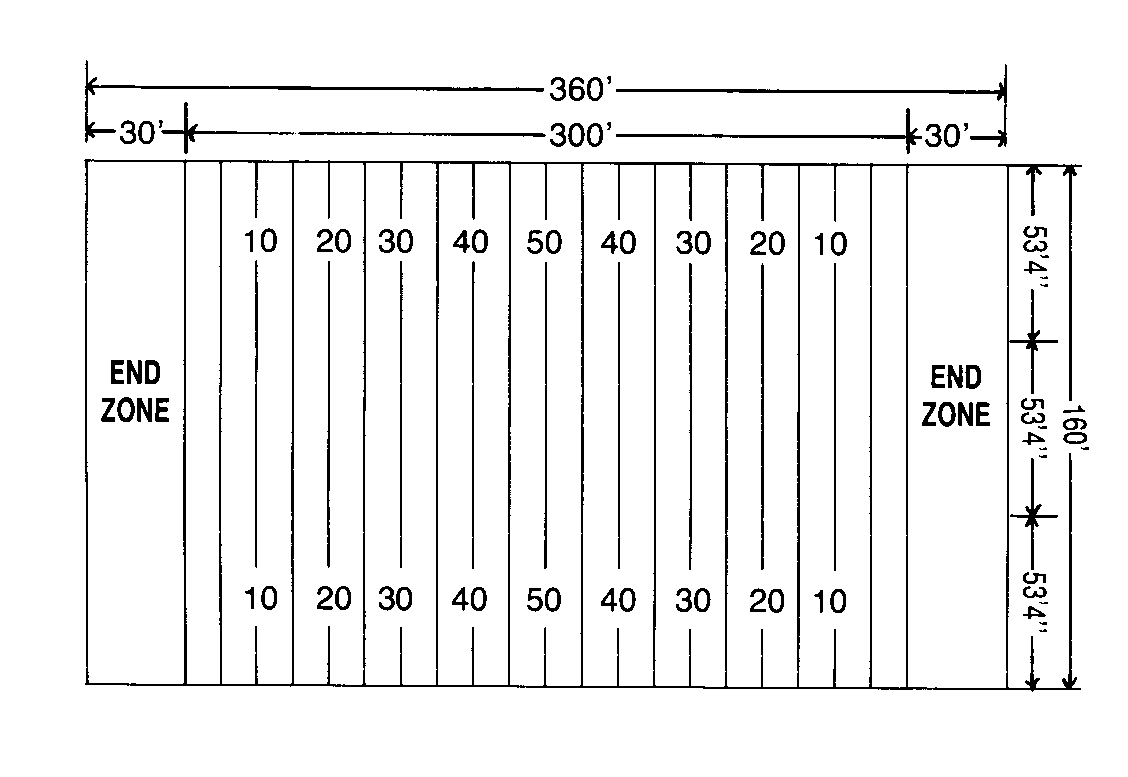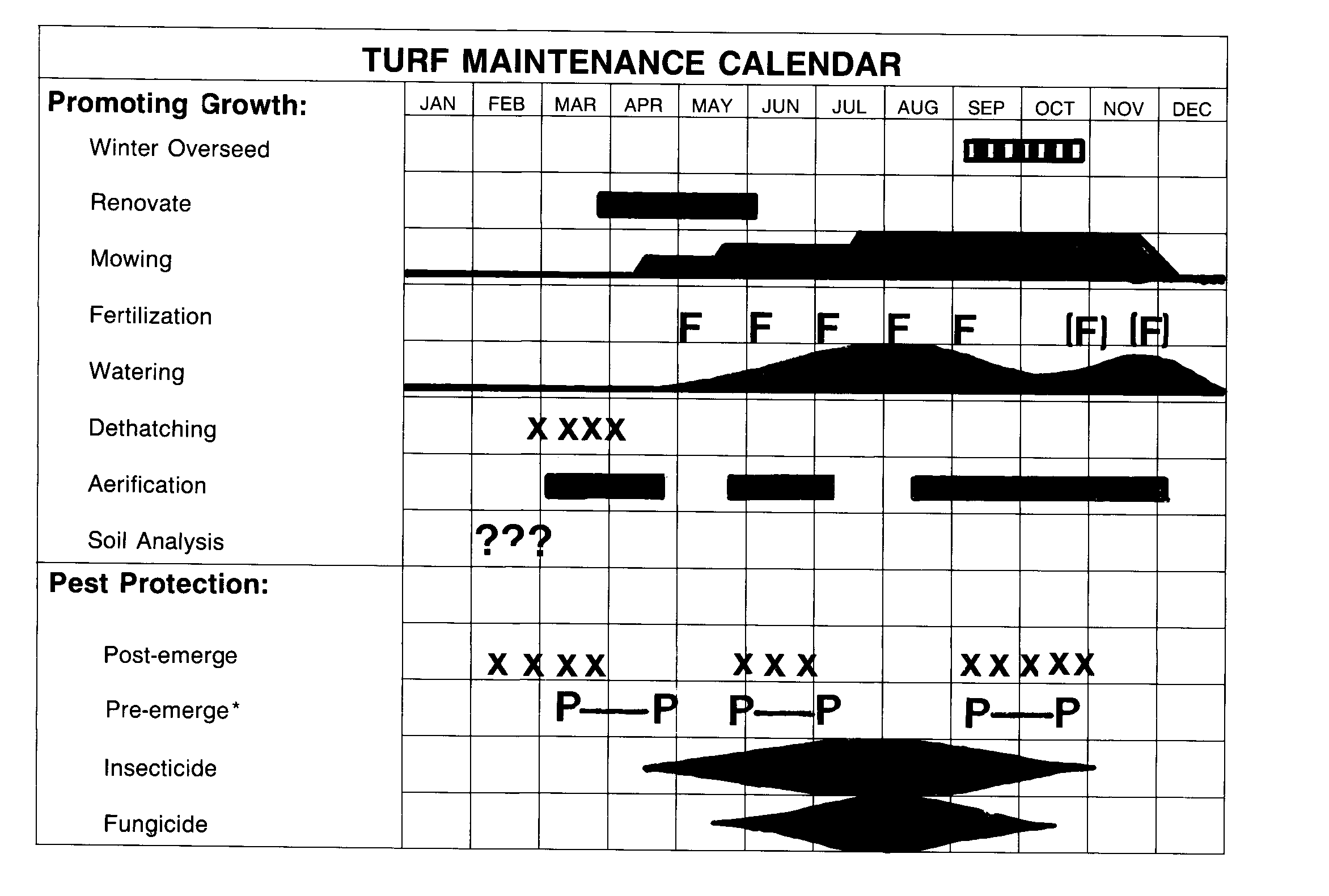Turfgrass Management of Bermudagrass Football Fields
The first step in developing a turfgrass management program for a football field is to understand the various component areas that make up the entire field. A regulation football field is 360 feet long and 160 feet wide, or 57,600 square feet, or 1.32 acres. Look at the field as 58 units of 1,000 square feet each and break the field down into component areas including the central playing area, the outer playing area, and the end zones (Figure 1). If you know the area of each component, it is easy to deter-mine the supplies (i.e., fertilizer, herbicides, seed, sod, etc.) you will need to maintain that area, It will also help when scheduling labor to do the various jobs.
A second consideration is the development of turfgrass maintenance practices to ensure a healthy stand of turf. A calendar of proposed management practices should be developed which take into account low, medium and high requirements for labor and materials needed for the different management areas on the field. The calendar can be divided into cultural practices which promote growth (i.e., watering, fertilizing, aerification, etc.), and those that pre-vent pest problems from occurring (i.e., weeds, insects, and disease).
a) Football Field
360’ x 160’ = 57,600 sq ft
one unit = 1000 sq ft
57.6 units 57,600 sq ft
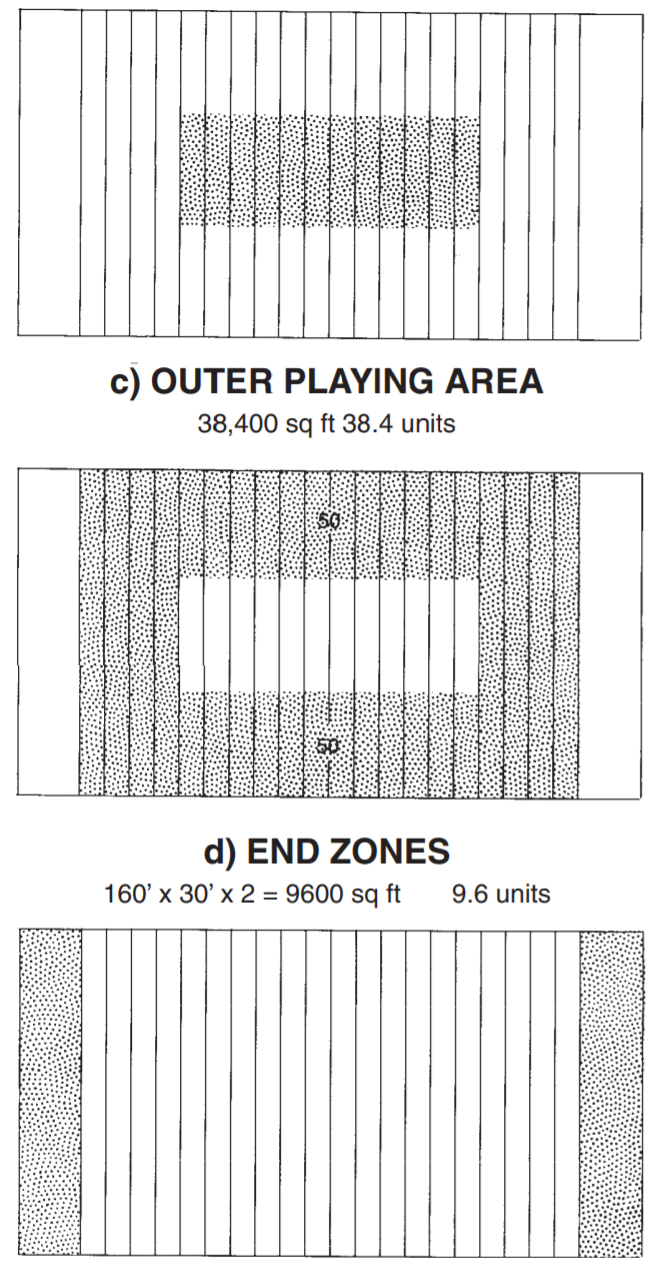
The central playing area will need more attention than the outer playing areas and end zones. Therefore, when preparing maintenance calendar (Figures 2, 3 and 4) for the football field, allocate more of your resources to the central playing area than the outer playing area and end zones. When scheduling work that will take more than one day, always start at the center of the field.
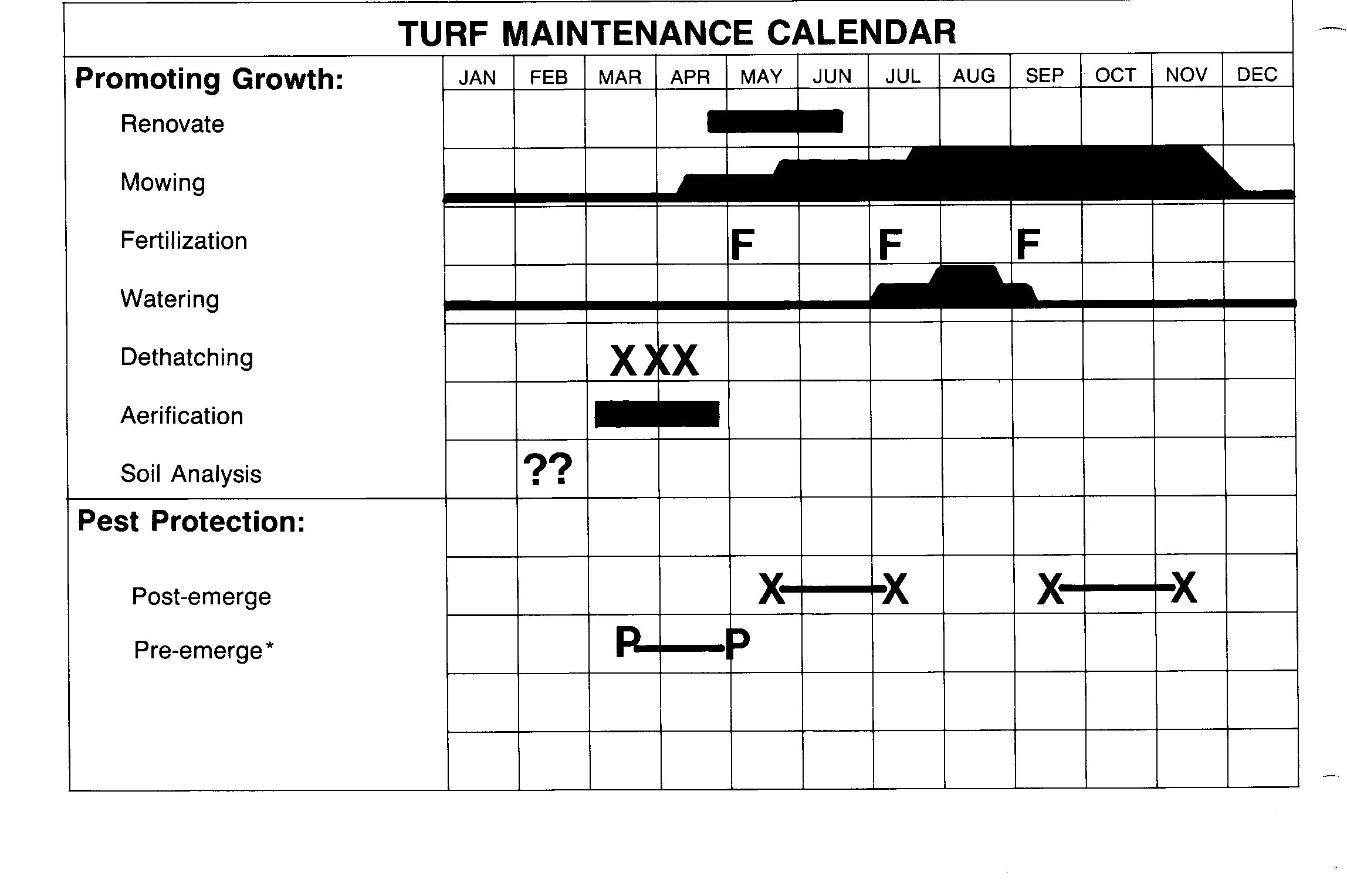
Figure 2. Minimum Care turf maintenance program for bermudagrass football fields in Oklahoma.
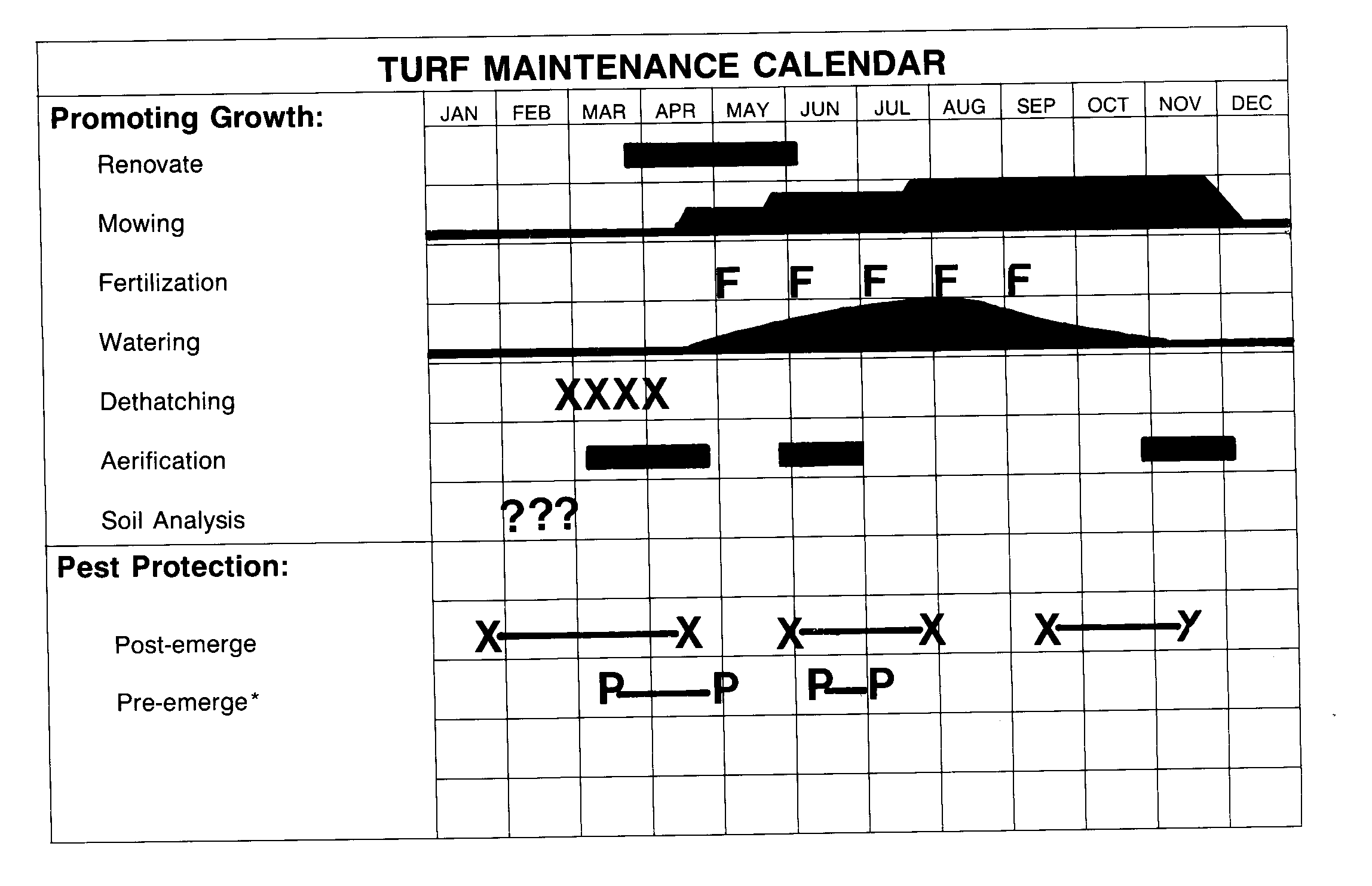
Figure 3. Medium care program for bermudagrass football fields in Oklahoma.
Minimum Care Program
Renovation
- Seed (2 lbs coated seed/1000 sq. ft.) or sprig (10 Bu./1000 sq. ft.) bermudagrass in the spring of each year in high traffic areas
Mowing
- Frequent and at proper height
- Spring 1 1/2 inches
- Summer 2 inches
- Fall 2 inches
Fertilizing
- Conduct basic soil test at least once every 3 years
- Three to five times per year (4 ‑6 Lbs. N/1000 sq. ft./year)
- Soluble nitrogen sources
- Do not apply more than 1.25 lbs N/1000 sq. ft. from a soluble nitrogen source in a single application.
- Make P and K fertilizations based on soil test results
- Fertilizer applied in July need only contain nitrogen
Watering
- Programmed to correspond with fertilization
- Avoid wilting during dry periods (July through August)
Dethatching
- Vertical mow areas where thatch has built up once in the spring
Aerification
- Three to five times during early spring before a pre-emergent herbicide is applied
Weed Control
- Post‑emergent herbicides to control broadleaf and grassy weeds.
- Pre‑emergent herbicide applied in spring to control annual grassy weeds
- Do not apply pre‑emergent herbicides in areas that are going to be renovated
Medium Care Program
Renovation
- Seed (2 lbs coated seed / 1000 sq. ft.) or sprig (10 Bu. / 1000 sq. ft.) bermudagrass in the spring of each year in high traffic areas
Mowing
- Frequent and at proper height
- Spring 3/4 inches
- Summer 1 1/2 inches
- Fall 1 1/2 inches
Fertilizing
- Conduct basic soil test at least once every 2 years
- Five times per year (6 Lbs. N/1000 sq. ft./year)
- Soluble nitrogen sources
- Make P and K fertilizations based on soil test results
- Fertilizer applied in June, July and August need only contain nitrogen
Watering
- Programmed to correspond with fertilization
- Maintain good color and vigor
Dethatching
- Vertical mow once in the spring those areas where thatch has built up
- Program to correspond with pre‑emergent herbicide applications
Aerification
- Five times per year, monthly starting in March
Weed Control
- Pre‑emergent herbicide applied in spring and early summer
- Post‑emergent herbicide applied in fall and late winter to control annual broadleaf and grassy weeds (a non-selective herbicide such as Roundup can be used during Bermuda dormancy in winter)
- Post‑emergent herbicides in summer to control annual broadleaf and grassy weeds
- Do not apply pre‑emergent herbicides in areas that are going to be renovated
Maximum Care Program
Winter Overseeding
- Seed football fields with perennial or intermediate ryegrass (10‑15 Lbs./1000 sq. ft.) in September
Renovation
- Sod or sprig (10 Bu./1000 sq. ft.) bermudagrass in the spring of each year in high traffic areas
Mowing
- Frequent and at proper height with a reel mower only
- Spring 3/4 inches
- Summer 1 inches
- Fall 1 to 1 1/2 inches
Fertilizing
- Conduct basic soil test at least once every year
- Five times (7 times if winter overseeding) per year (6 – 7 lbs. N/1000 sq. ft./year)
- Fast and slow‑release nitrogen sources
- Make P and K fertilizations based on soil test results
- Fertilizer applied in June and August need only contain nitrogen
Watering
- Program to correspond with fertilization, aerification, and herbicide treatments
- Maintain good color and vigor
- Never allow the field to wilt
Dethatching
- Vertical mow once in the spring those areas where thatch has built up (end zones)
- Programmed to correspond with pre‑emergent herbicide applications
Aerification
- Five times per year, monthly starting in March
Top Dressing
- Two times per year using a sand or sandy loam soil
- Program to correspond with renovation and over-seeding
Weed Control
- Pre‑emergent herbicides applied in fall, spring and early summer as per label
- Post‑emergent herbicides applied in late winter to control annual broadleaf and grassy weeds (a non‑selective herbicide such as Roundup can be used when bermuda is dormant)
- Post‑emergent herbicide applied in summer to control annual broadleaf and grassy weeds
- Do not apply pre‑emergent herbicides in areas that are going to be renovated
Insect Control
- Insect problems such as white grub, sod webworm, and cutworms can be controlled during the Spring and late summer of the year
Disease Control
- During the warm, humid spring and fall of the year control of plant diseases may be required. Damping off diseases can be a problem when overseeding with ryegrass
- A good breakdown of the athletic field areas combined with a maintenance calendar based on sound turfgrass recommendations can be used to develop a budget for the required labor and materials. Once this information is pulled together into a budgeted maintenance program, then the turfgrass manager has guidelines from which to conduct the maintenance program. It is not always possible to take into consideration every consequence when preparing a budget for turfgrass maintenance (i.e., weather, equipment breakdowns, unexpected pest problems, etc.), but with a good guideline, and subsequent record keeping on actual labor and material costs, the turfgrass manager will become more efficient at adequately budgeting and solving turfgrass problems.
The budget can be prepared using several different methods. However, when the fields are broken down into units of 1000 square feet, estimates for maintenance costs can be adjusted more easily. For example, the entire field may not need to be sodded, but it will need fertilizer. Fill in the frequency per field, the number of fields, the units per field, the amount of material or labor needed per unit, and the cost per amount needed (Table 1). The product of these five numbers will be the estimated expense for each item. Subtotal each maintenance practice, (i.e., Renovation, Mowing, Fertilization, etc.) and the total of all maintenance practices.
If the estimated budget is too large, then before eliminating an entire maintenance practice, try reducing the number of units per field or the frequency per field. Remember, the central playing field is around 10 units and will need more care and attention. Concentrate your resources on these 10 units and work outwards towards the sidelines and end zones.
Soil Fertility
Initial phosphorus (P) Test Index should be 65. If insufficient apply as per the following table.
Suggested Rate of P205 Application* in pounds
|
If P Test Index is |
or P Soil ppm is |
Add P2O5 Per 1000 sq. ft. |
Add P2O5 per acre |
Per standard Football Field (1.32 acres) |
|---|---|---|---|---|
|
10 |
5 |
1.4 |
60 |
79 |
|
20 |
10 |
0.9 |
40 |
53 |
|
30 |
15 |
0.7 |
30 |
40 |
|
40 |
20 |
0.5 |
20 |
26 |
|
65+ |
32 |
none |
none |
none |
*Ten pounds of 0‑20‑0 will equal 2 pounds of P205
*Ten pounds of 0‑45‑0 will equal 4.5 pounds of P205.
*One pound of P205 is equal to .44 pounds of (P) phosphorus.
Initial Potassium (K) Soil Test Index should be 250. If insufficient apply as per the following table.
Suggested Rate of K20 Application* in pounds
|
If K Test Index is |
or K Soil ppm is |
Add K2O per 1000 sq. ft. |
Add K2O per acre |
Per Standard Football Field (1.32 acres) |
|---|---|---|---|---|
|
60 |
30 |
3.2 |
140 |
185 |
|
75 |
38 |
1.8 |
80 |
106 |
|
125 |
63 |
1.1 |
50 |
66 |
|
200 |
100 |
0.7 |
30 |
40 |
|
250+ |
125 |
none |
none |
none |
*Ten pounds of 0‑0‑60 will equal 6 pounds of K20
*One pound of K20 is equal to .83 pounds of (K) potassium.
The recommended pH for bermudagrass is between 6 and 7. Never add lime unless recommended by a soil test. Limestone may be applied to raise the soil pH. Finely ground limestone acts faster than coarsely ground material. For turf use, at least one-half should pass a 100 mesh screen and all should pass a 10 mesh screen.
Suggested Rate in Pounds ECCE* Finely Ground Limestone
|
pH |
Suggested Rate in Pounds ECCE* |
|
|---|---|---|
|
Soil-buffer Index |
1000 sq. ft. |
Acre |
|
Over 7.1 |
0 |
0 |
|
7.1 |
15 |
667 |
|
7.0 |
15 |
667 |
|
6.9 |
23 |
1000 |
|
6.8 |
31 |
1333 |
|
6.7 |
39 |
1667 |
|
6.6 |
46 |
2000 |
|
6.5 |
61 |
2667 |
|
6.4 |
77 |
3333 |
|
6.3 |
92 |
4000 |
|
6.2 |
107 |
4667 |
|
6.1 |
122 |
5333 |
|
6.0 |
138 |
6000 |
*Effective Calcium Carbonate Equivalent
The most convenient times to make limestone applications are in the late fall, winter and early spring. Ground limestone can be applied at any time, but the summertime rate for hydrated lime should be under 1,000 pounds per acre, or 20 to 25 pounds per 1,000 square feet. Lime should not be applied immediately before or after fertilizer containing ammonia.
The lime, phosphorus and potassium can be incorporated into the soil to a depth of 4 to 6 inches at the time of establishment in order to achieve more immediate results.
Best Turfgrass Varieties
The best cold hardy, seeded bermudagrass types include Riviera and Yukon bermudagrass. The best cold hardy vegetative hybrid bermudagrasses include Latitude 36, NorthBridge and Patriot. Astro and common bermudagrass sold as U-3 have also proven useful on many athletic fields. Caution is recommended when considering Tifway due to its lower winter hardiness than the bermudagrasses previously discussed. Many perennial ryegrasses and intermediate ryegrasses are available for overseeding. Choose ryegrasses that are selected for better transition rather than exclusively choosing based on low price.
Field Drainage
Older field designs on heavy clay soil may call for as much as an 18‑inch crown (1.87 percent slope), turtle‑backed from center of field to sidelines, without pockets. In areas with sandy pervious soils, the slope may be reduced to one-quarter to one percent. The parallel sidelines should be level. Sand-based systems may be nearly flat. Place tile systems along the sidelines with catch basins to remove water more rapidly than it will be absorbed through the soil. Except for cases of seepage or high water tables, tiling the entire playing area may do little good because surface compaction impedes water movement to the tile except in the strips immediately over the tile lines.
Table 1: Intramural Maintenance Budget
* One unit is equal to 1,000 spare feet. Not all tasks will be required for the entire field, so use 1,000 square foot units to estimate materials and labor.
** Time required in “man-hours” to complete a given task on 1,000 square feet. You will need to keep your own records to determine the time it actually takes to complete these jobs.
+ Multiply columns 1 through 5 to produce the estimated expense for each item.
Dennis Martin
Extension Turfgrass Specialist

